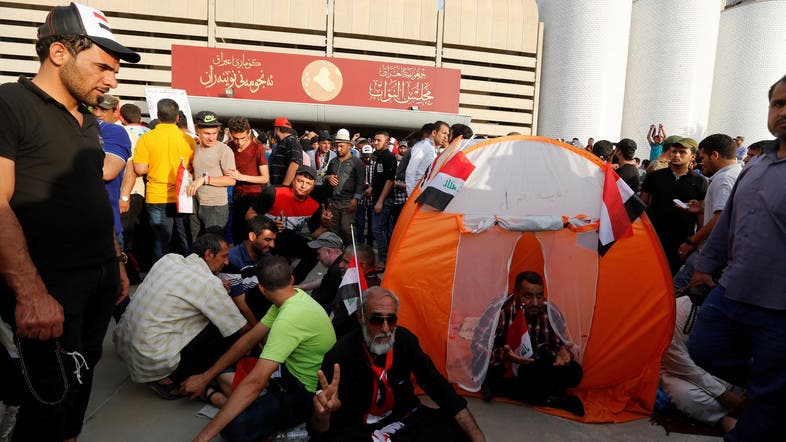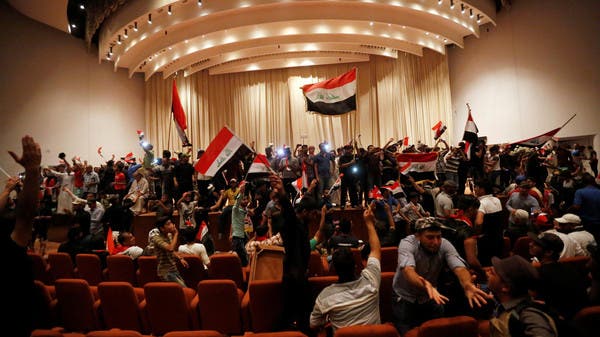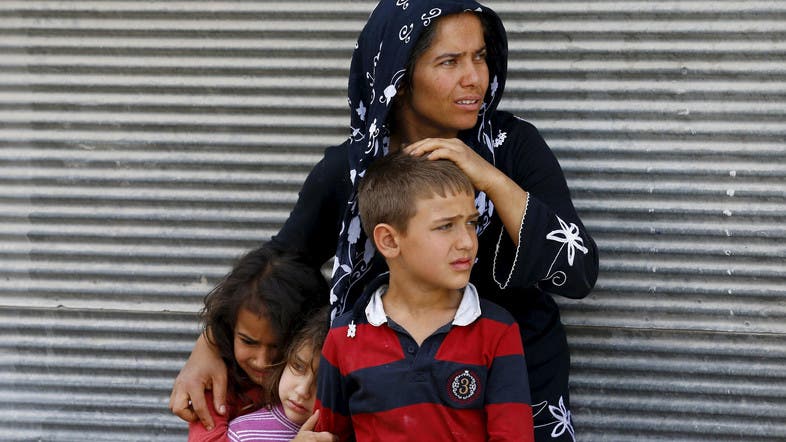 |
| Followers of Iraq’s Shiite cleric Moqtada al-Sadr are seen in the parliament building |
(With Reuters, AFP)
An AFP photographer said the protesters were leaving the parliament building they stormed earlier in the day.
Members
of the Sadrist militia group Saraya al-Salam could be seen ordering
protesters to move out of the compound, some six hours after they broke
into the fortified Green Zone area where the government is
headquartered.
An emergency state was
declared in Baghdad after hundreds of Sadr's supporters stormed the
Green Zone and some entered the parliament building. The protesters
stormed the parliament after lawmakers failed to convene for a vote on
overhauling the government.
Iraqi security
forces fired tear gas at one entrance of the zone but appeared to be
largely standing down as protesters marched through the area, chanting
and waving Iraqi flags. Hundreds were still pouring into the Green Zone
as night fell.
The protesters, who had gathered outside the heavily fortified district housing government buildings and foreign embassies, crossed a bridge over the Tigris River chanting, “The cowards ran away!” in apparent reference to lawmakers leaving parliament, one of the witnesses said.
The protesters, who had gathered outside the heavily fortified district housing government buildings and foreign embassies, crossed a bridge over the Tigris River chanting, “The cowards ran away!” in apparent reference to lawmakers leaving parliament, one of the witnesses said.
A guard at a checkpoint said the
protesters had not been searched before entering. TV footage showed them
waving Iraqi flags and chanting “Peaceful, peaceful!.” Some were
standing on top of concrete blast walls that form the outer barrier to
the Green Zone.
The protestors, many of whom were seen waving Iraq's national flag, were responding to calls made by Sadr.
This
week, lawmakers again failed to approve new cabinet ministers. Iraqi
Prime Minister Haider al-Abadi had been seeking to replace the previous
cabinet, which had been marred by allegations of corruption and
patronage.
In a press conference Sadr
denounced Iraqi political circles who are obstructing Abadi’s reforms
that would see current ministers replaced by technocrats with no party
affiliation to tackle systemic political patronage that has enabled
bribery and embezzlement. Sadr also called for a one-million man
“peaceful” demonstration.
“The political
sides want to suppress the reform movement,” he said, describing the
“reform movement as having only the interest of people in its core.”
He added: “[The reform movement] is for God, the will of people and Sadr has zero interest in it.”
Instead
those who are trying to cling to the status quo are those who want to
keep the “quota system” to keep “their interests intact,” he said.
Observers
have criticized Iraq’s quota system, which divides power between
Shiites, Sunnis and Kurds. The quota which keeps the presidency post for
a Kurd and the premiership for a Shiite are blamed for political
corruption, and weakening the state and its army.
Sadr
is so far the main Iraqi political figure, who is lending his weight to
push for Abadi’s reforms, stressed that the reform movement’s protests
“will continue to be peaceful.”
Last
Friday, Sadr warned political party leaders that they would face street
protests if they obstruct Abadi’s government overhaul to fight
corruption.
“You are not staying here!
This is your last day in the Green Zone,” shouted one protester as
thousands broke into the fortified area in central Baghdad.
EU condemns Iraq parliament protest
EU
foreign affairs commissioner Federica Mogherini on Saturday criticized
the storming of the Iraqi parliament by protesters as potentially
destabilizing the country.
“The reported
attack today on the Iraqi Parliament and the violent protests in Baghdad
risk to further destabilise an already tense situation,” Mogherini
said.
“It appears a deliberate disruption
of the democratic process. A rapid restoration of order is in the
interest of the Iraqi people, who have been suffering for too long for
the lack of stability in their country, and is in the interest of all
the region, confronted by many threats.”
“It’s
crucial that all Iraqis and all the regional and international actors
contribute to build a cooperative environment and a democratic,
inclusive political process to stabilize the country,” Mogherini
concluded.





